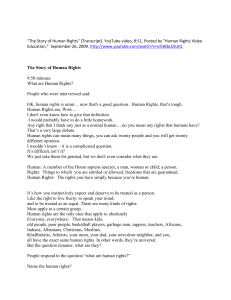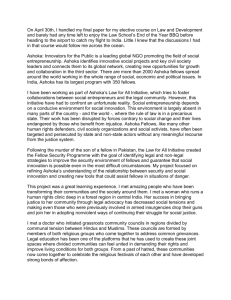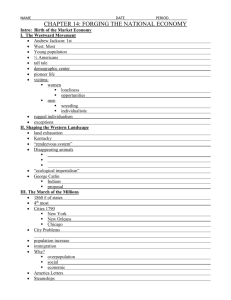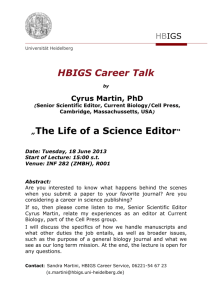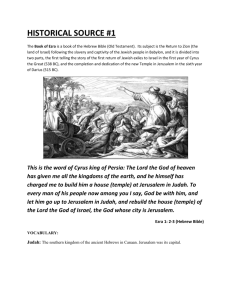world religion / Empire comparison
advertisement
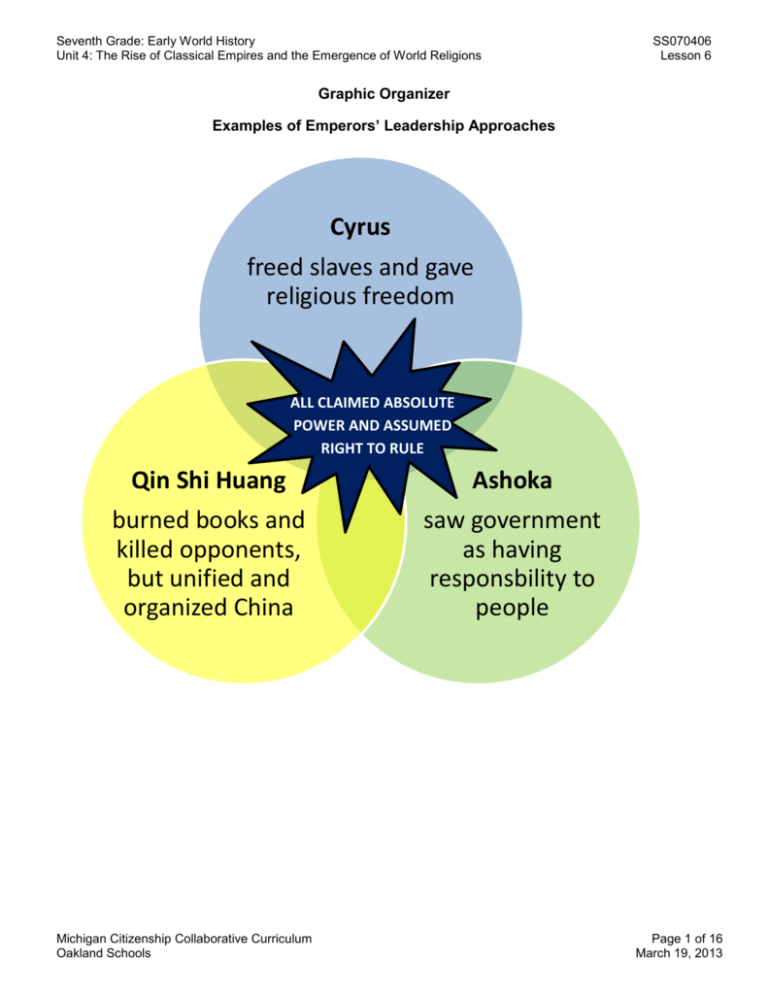
Seventh Grade: Early World History Unit 4: The Rise of Classical Empires and the Emergence of World Religions SS070406 Lesson 6 Graphic Organizer Examples of Emperors’ Leadership Approaches Cyrus freed slaves and gave religious freedom ALL CLAIMED ABSOLUTE POWER AND ASSUMED RIGHT TO RULE Qin Shi Huang Ashoka burned books and killed opponents, but unified and organized China saw government as having responsbility to people Michigan Citizenship Collaborative Curriculum Oakland Schools Page 1 of 16 March 19, 2013 Seventh Grade: Early World History Unit 4: The Rise of Classical Empires and the Emergence of World Religions SS070406 Lesson 6 Big Idea Card Big Ideas of Lesson 6, Unit 4 The authority of emperors during Era 3 was generally absolute, but how they used their power differed from one ruler to the next. Emperors justified their power in different ways, but assumed that they had the right or obligation to rule. Most emperors claimed a divine, or God-given, right to rule. Some emperors obtained power from being born into a specific family; they inherited power based on the idea of hereditary succession. Emperors sought to manage their people and societies through different means. Sometimes they used rewards, and other times they used force and punishment. Michigan Citizenship Collaborative Curriculum Oakland Schools Page 2 of 16 March 19, 2013 Seventh Grade: Early World History Unit 4: The Rise of Classical Empires and the Emergence of World Religions SS070406 Lesson 6 Word Cards 32 monarchy 31 yoke a wooden bar that connects two animals like oxen pulling a plow; the word is also used to represent something that is controlling or oppressive Example: Throughout human history, millions of people have suffered the yoke of slavery. (SS070406) a form of government in which one person has the power to rule Example: Sumer and Egypt, starting around 3000 BCE, were headed by kings and queens, which are the earliest monarchies we know about. (SS070406) 33 bureaucracy 34 dharma group of non-elected officials within a government or institution that implements the rules, laws, ideas and functions of their institution the virtue and right behavior (duty) necessary to maintain the natural order or balance of the universe, according to Hindu and Buddhist traditions; this word is difficult to translate into English Example: In order to make it easier to manage his empire, Emperor Qin created a bureaucracy by dividing his empire up into different provinces with two government officials in charge of each province. Example: One dharma of a child is to obey his/her parents, while one dharma of parents is to look after their children. (SS070406) (SS070406) 35 oppression prolonged cruel or unjust treatment or control Example: Emperor Qin’s reign was marked by oppression. He forced thousands of people to build the Great Wall and put many Confucian scholars to death. (SS070406) Michigan Citizenship Collaborative Curriculum Oakland Schools Page 3 of 16 March 19, 2013 Seventh Grade: Early World History Unit 4: The Rise of Classical Empires and the Emergence of World Religions SS070406 Lesson 6 Teacher Background Between 600 and 200 BCE, two emperors, Cyrus the Great of Persia (550-530 BCE) and Ashoka of the Mauryan Empire (272-232 BCE), stand out as reasonably enlightened rulers. Both ruled over far-flung empires that contained multi-ethnic populations. Neither Cyrus nor Ashoka foisted his religion on his subjects and neither presented himself as divine. Nevertheless, both mention their favorable relationship to the gods in their decrees, emphasizing their legitimacy. Cyrus was the founder of the Persian (Achaemenid) Empire. He was the leader of a minor Persian clan who led a rebellion against the Medes, the Persians’ overlords. In 539 BCE, Cyrus, who then controlled northern Mesopotamia, the Anatolian Peninsula, and Syria, attacked and conquered Babylon. On a large, oval baked clay cuneiform cylinder, now in the British Museum, Cyrus’s description of that success is recorded. It is written in Ancient Persian. In it Cyrus exhibits concern for the Babylonians, forbidding his soldiers to loot the city and proposing to help rebuild it. He also returns religious statues taken from conquered peoples, and he released people who had been enslaved by the Babylonians. For example, he frees some 40,000 Jews and later enables them to rebuild their temple in Jerusalem. In this document, Cyrus clearly guarantees freedom of religion. He also promises to protect private property and to outlaw forced labor. The document is often called the first charter of human rights. The Mauryan Empire reached its peak under Ashoka (271-232 BCE), Chandragupta’s grandson. Apparently, Ashoka began his rule as a ruthless autocrat. Legend says that he killed ninety-nine of his brothers in order to secure the throne for himself. Eventually, he seems to have had a change of heart. According to a stone pillar that he erected and inscribed, he renounced bloodshed after witnessing an especially horrifying battle. He then turned to Buddhism, a religion which had been developing in northern India since the birth of its founder, Siddhartha Gautama (Buddha, the Enlightened One) about 553 BCE. Early Buddhism stressed a code of ethics based on unselfishness, and it set forth rules for behavior (the Eightfold Path). A person simply had to live a moral, unselfish life in order to attain nirvana, the perfect peace which frees the soul from reincarnation. Ashoka considered himself responsible for the well-being of his subjects and tried to create a system of government based on dharma, that is, Buddhist moral and ethical principles. He defined these as non-violence, obedience to parents, tolerance of and respect for all opinions and sects, humane treatment of servants, kindness to all living beings, and generosity to all. He considered these principles so broad that no one, no matter his or her religious beliefs, could reasonably object to them. He broadcast these principles by carving them on rocks and stone pillars throughout his empire. Source: Lesson 2 – “Emperors speak for themselves.” Landscape Unit for Era 4. World History for Us All. San Diego State University. p. 29. 13 March 2013 <http://worldhistoryforusall.sdsu.edu> Michigan Citizenship Collaborative Curriculum Oakland Schools Page 4 of 16 March 19, 2013 Seventh Grade: Early World History Unit 4: The Rise of Classical Empires and the Emergence of World Religions SS070406 Lesson 6 Student Handout 1- Cyrus: Instructions - Read the Text in the Middle and take notes on each side. Try reading the text once to look for purpose, and then again to think about the big idea. This is a primary source, meaning that it was written for/by Cyrus during his rule. Purpose...why was it written? Look at each section to see if different parts might have a different purpose. Why does Cyrus want to show that he is descended from Kings? PRIMARY SOURCE: Cyrus the Great: The Decree of 539 BCE What kind of leader is Cyrus claiming to be? My numerous troops moved about undisturbed in the midst of Babylon. I did not allow anyone to terrorize the land of Sumer and Akkad. I kept in view the needs of Babylon and all its sanctuaries to promote their well being. The citizens of Babylon … I lifted their unbecoming yoke. Their dilapidated dwellings I restored. I put an end to their misfortunes… How do you think Cyrus wants to be remembered as a king? While I am the monarch, I will never let anyone take possession of movable and landed properties of the others by force or without compensation. While I am alive, I prevent unpaid, forced labor. Today, I announce that everyone is free to choose a religion. People are free to live in all regions and take up a job provided that they never violate other's rights. Big idea... what is the gist? (for each section) I am Cyrus, King of the world, great king, mighty king, king of Babylon, king of the land of Sumer and Akkad, king of the four quarters of the earth, son of Cambyses, great king, king of Anshân, grandson of Cyrus, great king, king of Anshân, descendant of Teispes, great king, king of Anshân, progeny of an unending royal line, whose rule Bel and Nabu cherish, whose kingship they desire for their hearts, pleasure… http://www.cais-soas.com/CAIS/Cyrus-the-Great/cyrus_cylinder.htm This is the site of the School of Oriental and African Studies (S0AS) at the University of London. The teaching unit author has simplified the text in places. http://worldhistoryforusall.sdsu.edu/ Page 31 World History for Us All Big Era 4 Landscape 4. Michigan Citizenship Collaborative Curriculum Oakland Schools Page 5 of 16 March 19, 2013 Seventh Grade: Early World History Unit 4: The Rise of Classical Empires and the Emergence of World Religions SS070406 Lesson 6 Making Inferences on Cyrus Think about the text above. Turn and Talk with a partner about these questions: 1) What is the overall purpose for this account about Cyrus? Why do you think it was written? Consider the source... what would Cyrus have wanted in the record of his rule? Use your answers to the questions above to help you think about this. Jot down your main idea below. Be ready to share your ideas with the class. Finish this statement: Cyrus had this document written in order to: ____________________________________________ _____________________________________________________________________________________________________________ _____________________________________________________________________________________________________________. 2) Why would Cyrus free slaves if he was a conquering emperor? Apart from maybe just wanting to be a good guy, what might he gain from this action? To help you answer this question, talk with your partner about each of these more specific questions: Who were the slaves? Who were the people controlling the slaves? Who was Cyrus conquering? How would this group (the ones Cyrus was conquering) feel about having their slaves freed? How would NOT having slaves anymore affect the former ruling group? So... why might Cyrus have freed these slaves? Talk about this again, and be prepared to share your thoughts with the class. What we are doing here is making an inference based on our own knowledge and the text. We can’t actually know what was going in Cyrus’ head... but we can make educated conjectures (guesses) based on evidence and reasoning. Michigan Citizenship Collaborative Curriculum Oakland Schools Page 6 of 16 March 19, 2013 Seventh Grade: Early World History Unit 4: The Rise of Classical Empires and the Emergence of World Religions SS070406 Lesson 6 Teacher Reference Sheet for Student Handout 1 - Cyrus Michigan Citizenship Collaborative Curriculum Oakland Schools Page 7 of 16 March 19, 2013 Seventh Grade: Early World History Unit 4: The Rise of Classical Empires and the Emergence of World Religions SS070406 Lesson 6 Teacher Reference Sheet - Making Inferences on Cyrus Michigan Citizenship Collaborative Curriculum Oakland Schools Page 8 of 16 March 19, 2013 Seventh Grade: Early World History Unit 4: The Rise of Classical Empires and the Emergence of World Religions SS070406 Lesson 6 Student Handout #2 - Ashoka Instructions - Read the Text in the Middle and take notes on each side. Try reading the text once to look for purpose, and then again to think about the big idea. Purpose...why was it written? Look at each section to see if different parts might have a different purpose. Big idea... what is the gist? PRIMARY SOURCE: (for each section) Ashoka: Excerpts from His Rock Edict Inscriptions, c. 258 BCE Why do you think Ashoka calls King Priyadarsi (Ashoka), Beloved of the Gods, honors men of all himself “Beloved of the Gods”? religious communities with gifts and with honors of various kinds, irrespective of whether they are ascetics or householders….This indeed is the desire of the Beloved of the Gods, that persons of all sects become well informed about the doctrines of different religions and acquire pure knowledge. What kind of leader does And the growth of the essentials of Dharma is possible in many ways. Ashoka claim to be? But its root lies in restraint in regard to speech, which means that there should be no extolment of one’s own sect or disparagement of other sects on inappropriate occasions and that it should be moderate in every case even on appropriate occasions. On the contrary, other sects should be duly honored in every way on all occasions; if a person acts in this way, he not only promotes his own sect but also benefits other sects. How does Ashoka want to be remembered? 4 All men are my children. Just as, in regard to my own children, I desire that they shall be provided with all kinds of welfare and happiness in this world and the next, the same as I also desire in regard to all men. 5 Everywhere King Priyadarsi Beloved of the Gods, has arranged for two kinds of medical treatment, viz., medical treatment for men and medical treatment for animals. And where there were no roots and fruits, they have been caused to be imported and planted. On the roads, wells have been caused to be dug and trees have been caused to be planted for the enjoyment of animals and men? Michigan Citizenship Collaborative Curriculum Oakland Schools 6 Page 9 of 16 March 19, 2013 Seventh Grade: Early World History Unit 4: The Rise of Classical Empires and the Emergence of World Religions SS070406 Lesson 6 Making Inferences on Ashoka Think about the text above. Turn and Talk with a partner about these questions: 1) What is the overall purpose for this document about Ashoka? Why do you think it was written? Consider the source... what would Ashoka want to be remembered for? Use your answers to the questions above to help you think about this. Jot down your main idea below. Be ready to share your ideas with the class. Finish this statement: Ashoka had this document written in order to: ____________________________________________ _____________________________________________________________________________________________________________ _____________________________________________________________________________________________________________. 2) Think about the text above. Stop and Jot on your own about the questions below, then Turn and Talk with a partner to share your ideas: What seems to be driving Ashoka? What evidence is there that Buddhism influenced Ashoka’s leadership? How do the ideas in this text compare to the ideas of Cyrus? Do you think Cyrus and Asoka had the same ideas about leadership? Why? Michigan Citizenship Collaborative Curriculum Oakland Schools Page 10 of 16 March 19, 2013 Seventh Grade: Early World History Unit 4: The Rise of Classical Empires and the Emergence of World Religions SS070406 Lesson 6 Teacher Reference Sheet for Student Handout #2 - Ashoka Michigan Citizenship Collaborative Curriculum Oakland Schools Page 11 of 16 March 19, 2013 Seventh Grade: Early World History Unit 4: The Rise of Classical Empires and the Emergence of World Religions SS070406 Lesson 6 Teacher Reference Sheet for Making Inferences on Ashoka Student Handout 3 – Comparing Cyrus and Ashoka Using what you have learned about Cyrus and Ashoka, complete the dialogue below: What makes an effective leader? Ashoka of the Mauryan Cyrus of Persia Michigan Citizenship Collaborative Curriculum Oakland Schools Page 12 of 16 March 19, 2013 Seventh Grade: Early World History Unit 4: The Rise of Classical Empires and the Emergence of World Religions SS070406 Lesson 6 How does one earn the right to become an emperor? Where does your power come from? Ashoka of the Mauryan Michigan Citizenship Collaborative Curriculum Oakland Schools Cyrus of Persia Page 13 of 16 March 19, 2013 Seventh Grade: Early World History Unit 4: The Rise of Classical Empires and the Emergence of World Religions SS070406 Lesson 6 Student Handout 4- Qin: For a different take on leadership, read about Emperor Qin Shi Huang of China below. Well... aren’t they warm and fuzzy. I’ll tell you how to rule! Bureaucracy: To control his people, First Emperor Qin (pronounced “cheen”) developed a system of bureaucracy. He divided his empire into 36 provinces. Each province was divided into districts. He put two government officials in charge of each province. It was their job to put strong people in charge of each district. Workers were well trained and paid. They reported to supervisors. People at each level supervised those below them. Spy System: To make sure everyone did their job correctly, First Emperor Qin set up a spy system. People had to spy on each other - it was the law. People had to spy on each at work and at home in their neighborhood or village. If people turned in lawbreakers, they were rewarded. If they did not, they were executed. It was a simple system, and it worked very well. This organization system gave Qin great power. That power allowed him to make huge changes. Qin knew that to unify China there had to be big changes. Most of his laws had something to do with protection. Changes: Land: First Emperor Qin took land away from the nobles. He did not want the nobles rising up against him. Anyone who argued with Qin was either buried alive or put to work building the Great Wall. Standardization: He introduced one system of weights, measures, money, written language, and laws. Nobody argued with him. Law Code: He introduced a new law code that applied to everybody. He created a huge law enforcement group, whose job was to enforce the laws. Peasants: Peasants were assigned a job. They were either assigned the job of farmer or of silk maker. It they tried to do anything else besides their assigned job, they were sent to work on the Great Wall. If people were lazy or slow at doing their assigned job, they were sent to work on the wall. Confucius wrote some advice to leaders. He wrote that, “If you are courteous, you will not be disrespected; If you are generous, you will gain everything. If you are honest, people will rely on you. If you are persistent, you will get results. If you are kind, you can employ people.” He also wrote, “What you do not want done to yourself, you do not want to do to others.” QuickWrite: Given the ideas of Confucius, why do you think Qin Shi Huang had all of his books burned? What is the evidence that Qin Shi Huang probably didn’t agree with Confucius? The Qin Dynasty – Ancient China for Kids. Mr. Donn. 19 March 2013 <http://china.mrdonn.org/qin.html>. Michigan Citizenship Collaborative Curriculum Oakland Schools Page 14 of 16 March 19, 2013 Seventh Grade: Early World History Unit 4: The Rise of Classical Empires and the Emergence of World Religions SS070406 Lesson 6 Student Handout 5: Emperor Comparison Chart Cyrus How does he justify his right to rule... in other words, who put him in charge? Ashoka Qin Shi Huang Chinese emperors at this time claimed they had a “Mandate from Heaven” to rule. In other words, they claimed the gods allowed them to rule. How did he treat his subjects (people he ruled over)? What types of responsibilities do you think he feels towards his people? How are they similar and how are they different in terms of leadership style? In which of these three empires would you want to live? Why? Exit Pass: Whose leadership do you think would have been more effective in controlling a large empire? Why? Support your idea with evidence/examples from the lesson. Michigan Citizenship Collaborative Curriculum Oakland Schools Page 15 of 16 March 19, 2013 Seventh Grade: Early World History Unit 4: The Rise of Classical Empires and the Emergence of World Religions SS070406 Lesson 6 Teacher Reference Sheet for Student Handout 5: Emperor Comparison Chart Michigan Citizenship Collaborative Curriculum Oakland Schools Page 16 of 16 March 19, 2013

